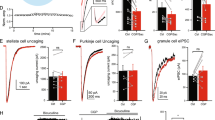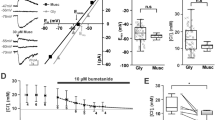Abstract
ARACHIDONIC acid is released by phospholipase A2 when activation of N-methyl-D-aspartate (NMDA) receptors by neurotransmitter glutamate raises the calcium concentration in neurons1,2, for example during the initiation of long-term potentiation and during brain anoxia3,4. Here we investigate the effect of arachidonic acid on glutamate-gated ion channels by whole-cell clamping isolated cerebellar granule cells. Arachidonic acid potentiates, and makes more transient, the current through NMDA receptor channels, and slightly reduces the current through non-NMD A receptor channels. Potentiation of the NMDA receptor current results from an increase in channel open probability, with no change in open channel current. We observe potentiation even with saturating levels of agonist at the glutamate- and glycine-binding sites on these channels; it does not result from conversion of arachidonic acid to lipoxygenase or cyclooxygenase derivatives, or from activation of protein kinase C. Arachidonic acid may act by binding to a site on the NMDA receptor, or by modifying the receptor's lipid environment. Our results suggest that arachidonic acid released by activation of NMDA (or other) receptors will potentiate NMDA receptor currents, and thus amplify increases in intracellular calcium concentration caused by glutamate. This may explain why inhibition of phospholipase A2 blocks the induction of long-term potentiation5.
This is a preview of subscription content, access via your institution
Access options
Subscribe to this journal
Receive 51 print issues and online access
$199.00 per year
only $3.90 per issue
Buy this article
- Purchase on Springer Link
- Instant access to full article PDF
Prices may be subject to local taxes which are calculated during checkout
Similar content being viewed by others
References
Dumuis, A., Sebben, M., Haynes, L., Pin, J.-P. & Bockaert, J. Nature 336, 68–70 (1988).
Lazarewicz, J. W., Wroblewski, J. T. & Costa, E. J. Neurochem. 55, 1875–1881 (1990).
Lynch, M. A., Errington, M. L. & Bliss, T. V. P. Neuroscience 30, 693–701 (1989).
Rehncrona, S., Westerberg, E., Akesson, B. & Siesjö, B. K. J. Neurochem. 38, 84–93 (1982).
Okada, D., Yamagishi, S. & Sugiyama, H. Neurosci. Lett. 100, 141–146 (1989).
Barbour, B., Szatkowski, M., Ingledew, N. & Attwell, D. Nature 342, 918–920 (1989).
Sarantls, M. & Attwell, D. Brain Res. 516, 322–325 (1990).
Mayer, M. L., Vyklicky, L. Jr & Clements, J. Nature 338, 425–427 (1989).
Sather, W., Johnson, J. W., Henderson, G. & Ascher, P. Neuron 4, 725–731 (1990).
Patneau, D. K. & Mayer, M. L. J. Neurosci 10, 2385–2399 (1990).
Nowak, L., Bregestowski, P., Ascher, P., Herbet, A. & Prochiantz, A. Nature 307, 462–465 (1984).
Christine, C. W. & Choi, D. W. J. Neurosci. 10, 108–116 (1990).
Sprosen, T. S. & Woodruff, G. N. Eur. J. Pharmac. 179, 477–478 (1990).
Salari, H., Braquet, P. & Borgeat, P. Prostaglandins, Leukotrienes & Medicine 13, 53–60 (1984).
Capdevila, J. et al. Arch. Biochem. Biophys. 261, 257–263 (1988).
Piomelli, D. et al. Nature 328, 38–43 (1987).
Rüegg, U. T. & Burgess, G. M. Trends Pharmac. Sci. 10, 218–220 (1989).
Sekiguchi, K., Tsukuda, M., Ase, K., Kikkawa, U. & Nishizuka, Y. J. Biochem. (Tokyo) 103, 759–765 (1988).
Goppelt-Streube, M., Koerner, C.-F., Hausmann, G., Gemsa, D. & Resch, K. Prostaglandins 32, 373–385 (1986).
Axelrod, J., Burch, R. M. & Jelsema, C. L. Trends Neurosci. 11, 117–123 (1988).
Williams, J. H. & Bliss, T. V. P. Neurosci. Lett. 88, 81–85 (1988).
Linden, D. J., Sheu, F. S., Murakami, K. & Routtenberg, A. J. Neurosci. 7, 3783–3792 (1987).
Malenka, R. C. Neuron 6, 53–60 (1991).
Davies, J., Evans, R. K., Jones, A. W., Smith, D. A. S. & Watkins, J. C. Comp. Biochem. Physiol. 72C, 211–224 (1982).
Cull-Candy, S. G., Howe, J. R. & Ogden, D. C. J. Physiol. 400, 189–222 (1988).
CRC Handbook of Chemistry & Physics (1971–1972) 52nd edn (ed. Weast, R. C.) F-47 (Chemical Rubber Co., 1971).
Author information
Authors and Affiliations
Rights and permissions
About this article
Cite this article
Miller, B., Sarantis, M., Traynelis, S. et al. Potentiation of NMDA receptor currents by arachidonic acid. Nature 355, 722–725 (1992). https://doi.org/10.1038/355722a0
Received:
Accepted:
Issue Date:
DOI: https://doi.org/10.1038/355722a0
This article is cited by
-
Salicylate- and Noise-induced Tinnitus. Different Mechanisms Producing the same Result? An Experimental Model
Indian Journal of Otolaryngology and Head & Neck Surgery (2023)
-
Radial symmetry in a chimeric glutamate receptor pore
Nature Communications (2014)
-
The Role of Secretory Phospholipase A2 in the Central Nervous System and Neurological Diseases
Molecular Neurobiology (2014)
-
Activation of protease activated receptor 1 increases the excitability of the dentate granule neurons of hippocampus
Molecular Brain (2011)
-
Baifuzi reduces transient ischemic brain damage through an interaction with the STREX domain of BKCa channels
Cell Death & Disease (2010)
Comments
By submitting a comment you agree to abide by our Terms and Community Guidelines. If you find something abusive or that does not comply with our terms or guidelines please flag it as inappropriate.



